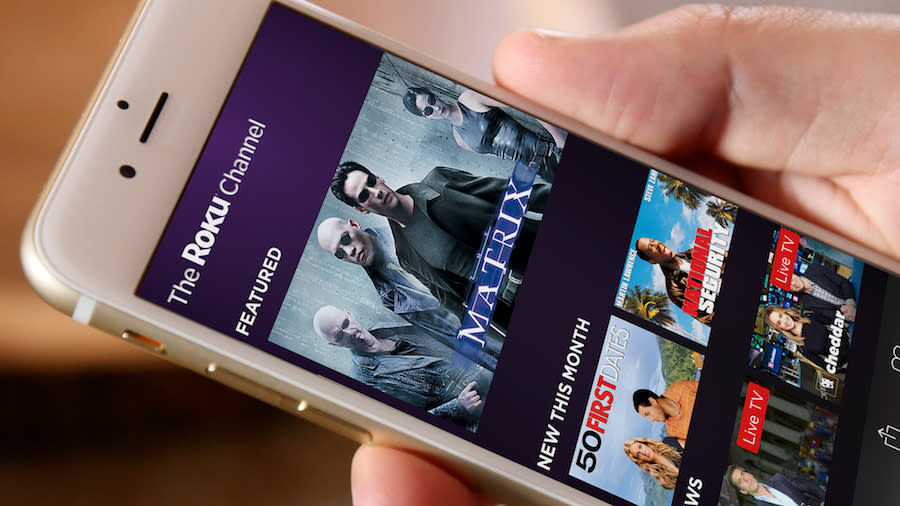Analyst Sees Path for Roku Stock to Triple in 5 Years
Roku (NASDAQ: ROKU) had a stellar start to 2019 with the stock gaining more than 100% through early May. Then came a strong earnings report last week that drove the stock up another 25% on the day after its release. With so much stock growth of late, it was surprising that an analyst this month would suggest the streaming pioneer still had a long way to go, and its stock could potentially triple over the next three to five years.
That's either a really bold claim or a foolhardy one. Sure, Roku is at the beginning of a sea change from broadcast to digital advertising and has a growing installed base of devices and impressive subscriber metrics. But could it possibly triple over the next several years after already tripling over the past two?
Let's take a look to see if his argument holds water.

Image source: Roku.
There are benefits in being a gatekeeper
Stephens analyst Kyle Evans said he believes the Roku's position as a gatekeeper between consumers, content providers, and advertisers will allow Roku to benefit from the shift to streaming without having to spend a mint buying content.
"We believe there is real value, mostly still unlocked, in [Roku's] ability to provide aggregation, discovery, and management solutions to the consumer and monetize this highly strategic position with advertisers and content providers," Evans explained.
The company is also platform agnostic, bringing together content from a host of providers. By comparison, rivals like Apple and Amazon are trying to lure viewers to their own streaming ecosystems with the Apple TV and Amazon Fire TV -- with the commensurate monthly fees. Roku makes the bulk of its money via advertising, so it can afford to treat all its content providers equally.
Advertising will be the fuel that drives Roku's growth
With the changing media landscape, advertising is slowly transitioning from broadcast and cable television to streaming platforms. The new paradigm is only just beginning to take shape, and Roku was one of the first companies to position itself to benefit from the trend.
Roku has a lot of room to grow its advertising business. Industry-wide, digital video ad spending is expected to grow 20% year over year as more advertisers make the move to streaming. This put potential advertisers right in Roku's wheelhouse. Even more compelling is a report from Roku last year on ad spending that revealed that ads on its platform were 67% more effective at driving purchase intent than ads shown on traditional broadcast television.
One recent example of Roku's ad growth potential was reported in its first-quarter earnings. Roku's platform revenue (which is primarily advertising) grew by 79% year over year, accelerating from the 74% and 77% growth in the third and fourth quarters of last year.
The company has produced year-over-year platform growth above 70% every quarter since going public in mid-2017. Additionally, Roku said monetized ad impressions more than doubled last quarter, and the company expects that trend to continue throughout 2019.
Doing what Netflix didn't dare to do
Investors may not recall that the original Roku device -- and in fact the company -- was the brainchild of Netflix (NASDAQ: NFLX). In late 2007, Netflix had developed the Netflix Player, a compact device that viewers could easily connect to their television sets in order to stream movies and television shows.
But Netflix CEO Reed Hastings had second thoughts about the device. He thought that, if Netflix manufactured its own box, it would create competition for the DVD and television manufacturers who were agreeing to put the red "Netflix" button on their remotes. Hastings made the decision to spin off the player and its team as a separate company, which became Roku.
Why does this matter? Roku's CEO Anthony Wood took the same approach and developed a custom operating system that is becoming increasingly ubiquitous on various devices (it was embedded in 1 in 3 smart TVs sold in the U.S. during the first quarter). The strategy of courting all television manufacturers and remaining neutral puts Roku's platform within arm's length of a growing number of consumers hungry for streaming.
Stephens pointed out that Roku also took great pains to ensure customers get an easy-to-use interface. This, combined with its large and growing base of compatible devices, makes it the default ad-supported streaming platform for an audience that welcomes opportunities to avoid complications.

Image source: Roku.
The proof is in the pudding
In its first-quarter earnings report, Roku revealed two metrics about its users that illustrate the strength of its position. First, active user accounts grew 40% year over year to more than 29 million. Second, its customer engagement is soaring, as streaming hours ballooned 74% to 8.9 billion hours.
Roku's position as a content aggregator and its ability to match consumers and advertisers -- as both make the transition from broadcast and cable to streaming -- puts the company in a unique position to ride this ongoing trend and potentially fulfill that triple-play prediction.
More From The Motley Fool
John Mackey, CEO of Whole Foods Market, an Amazon subsidiary, is a member of The Motley Fool's board of directors. Danny Vena owns shares of Amazon, Apple, Netflix, and Roku. The Motley Fool owns shares of and recommends Amazon, Apple, and Netflix. The Motley Fool has the following options: long January 2020 $150 calls on Apple and short January 2020 $155 calls on Apple. The Motley Fool recommends Roku. The Motley Fool has a disclosure policy.

 Yahoo Finance
Yahoo Finance 